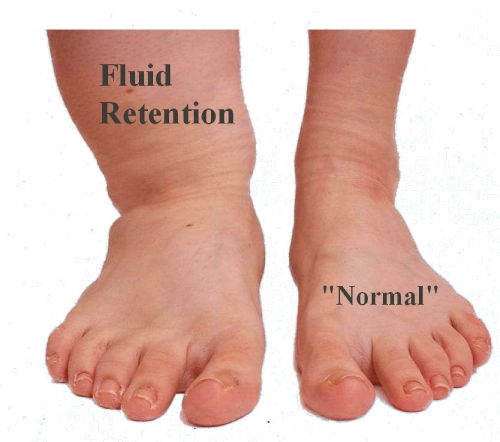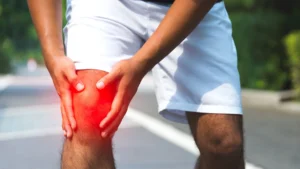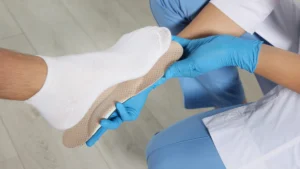Most people with flat feet experience edema, or swelling, which can lead to discomfort and mobility issues. If you’re struggling with this condition, understanding the steps to alleviate your symptoms can significantly improve your quality of life. This listicle outlines ten key strategies that are necessary for managing edema related to flat feet. By incorporating these methods into your daily routine, you can reduce swelling, enhance support for your feet, and regain your comfort and confidence in movement. Let’s investigate these effective approaches that can help you achieve relief.
The Physiology of Edema in Flat Feet
Understanding the physiology of edema in flat feet is crucial for managing fluid retention effectively. Flat feet may lead to structural misalignment, impacting how your body distributes weight and pressure. This can result in increased fluid accumulation in the lower extremities, particularly in the feet and ankles, due to impaired lymphatic drainage and venous return. As a result, the delicate balance of fluid levels in your body gets disrupted, leading to noticeable swelling.
How Flat Feet Contribute to Fluid Retention
Flat feet contribute to fluid retention through improper alignment and altered biomechanics. When your arch collapses, it causes uneven weight distribution across your feet, leading to increased pressure in certain areas. This pressure hampers effective fluid circulation, creating an environment where excess fluid can accumulate in your tissues, particularly in the lower legs and feet.
The Role of Poor Circulation in Edema Development
Poor circulation plays a significant role in the development of edema, particularly for individuals with flat feet. When blood flow is insufficient, it compromises the body’s ability to transport nutrients and remove waste products effectively. In your lower extremities, where circulation may be compromised due to flat feet, you may find that the venous system struggles to return blood to the heart. Consequently, this leads to increased pressure in the blood vessels, causing fluid to leak into surrounding tissues and contributing to swelling.
Lifestyle Tweaks for Reduction
Making simple lifestyle adjustments can significantly minimize edema associated with flat feet. Incorporating regular low-impact exercises, such as swimming or cycling, can improve circulation and reduce swelling. Staying hydrated and maintaining a balanced diet rich in potassium can also help manage fluid retention. Additionally, practicing good posture and avoiding prolonged standing or sitting can aid in alleviating discomfort. These small changes can lead to noticeable improvements in your condition, enhancing your overall foot health.
Effective Footwear Choices
Selecting the right footwear is vital for managing edema linked to flat feet. Opt for shoes with proper arch support and cushioning to alleviate pressure on your feet. Avoid high heels and tight-fitting shoes that can exacerbate swelling, and consider footwear made from breathable materials. When trying on shoes, ensure there is enough room in the toe box and that your heels stay securely in place to prevent unnecessary movement that could lead to discomfort.
Importance of Elevation Techniques
Incorporating elevation techniques into your routine is vital for reducing foot swelling caused by flat feet. When you elevate your feet, gravity helps return excess fluid from the lower extremities, thus alleviating discomfort and promoting better circulation. Aim to elevate your feet above the level of your heart for optimal results, which can be easily achieved by lying down and propping your legs on pillows or using a reclining chair. Regularly setting aside time to elevate your feet, especially after long periods of standing, can make a significant difference in managing edema and enhancing your overall comfort.
Exercise Strategies for Edema Relief
Engaging in appropriate exercise can significantly reduce edema related to flat feet. By incorporating a combination of strengthening and stretching routines into your daily life, you can enhance circulation while reducing swelling. Tailoring your exercise strategies to your specific needs will promote better foot function, improve mobility, and ultimately provide relief from discomfort associated with edema.
Strengthening Exercises that Help
Strengthening exercises can help support your arches and the overall stability of your feet. Focus on activities like toe raises, heel walks, and resistance band exercises that target the foot and lower leg muscles. By building strength in these areas, you can alleviate pressure on ligaments and tendons, thus mitigating edema and improving your foot health.
Stretching Routines to Improve Circulation
Incorporating stretching routines helps improve circulation in your feet and lower legs, which can reduce edema. Focus on stretches that target the calf muscles, Achilles tendon, and the intrinsic muscles of the foot. Simple techniques like gentle ankle circles, calf stretches against a wall, and toe stretches can enhance flexibility and promote blood flow, reducing swelling and discomfort.
To effectively implement stretching routines, dedicate time each day to perform these exercises. Aim for holding each stretch for at least 15–30 seconds, gradually increasing your range of motion while listening to your body. Consistency is key, so consider integrating stretching into your morning or evening routine. This practice not only works to improve circulation but can also contribute to overall foot health and comfort, making it an crucial component of managing edema associated with flat feet.
Dietary Adjustments that Combat Swelling
To effectively manage edema associated with flat feet, your diet plays an crucial role. Incorporating specific foods can help reduce inflammation and limit the severity of swelling. By making simple dietary adjustments and focusing on nutrient-dense foods, you can improve your overall well-being and support your body’s ability to manage excess fluid retention.
Foods with Anti-Inflammatory Properties
Incorporating foods rich in anti-inflammatory properties, such as fatty fish, berries, leafy greens, and nuts, can be beneficial for reducing swelling. These foods help combat inflammation, which is often a contributor to edema. By including them in your diet, you can support your body’s healing processes and potentially alleviate some symptoms associated with flat feet.
The Importance of Hydration and Sodium Management
Balancing your fluid intake and sodium levels is vital in managing edema. Drinking adequate water helps flush out excess salt and toxins, reducing fluid retention in your body. Additionally, limiting your sodium consumption can lead to lowered blood pressure and minimized swelling. By being mindful of both hydration and sodium management, you can take significant steps toward alleviating your edema symptoms.
Maintaining proper hydration and sodium management is highly beneficial for those experiencing edema. When you stay well-hydrated, your body is better equipped to regulate its fluid levels, which helps combat swelling. Aim to drink at least eight glasses of water daily, adjusting as needed based on your activity level. Concurrently, keeping your sodium intake in check—ideally below 2,300 mg per day—can help mitigate fluid retention. By combining hydration with mindful dietary choices, you can significantly improve how your body handles swelling and enhance your overall comfort.
Seeking Professional Help: When to Consult a Specialist
If you are experiencing persistent edema associated with flat feet, seeking professional help is imperative. Indicators that it’s time to consult a specialist include swelling that doesn’t improve with home remedies, pain that limits your daily activities, or any signs of infection. A healthcare professional can assess your symptoms more thoroughly and guide you toward the most effective treatment options tailored to your specific needs.
Diagnosing Underlying Conditions
Consulting a healthcare provider is vital for diagnosing any underlying health or foot conditions that may contribute to your edema. Conditions such as arthritis, diabetes, or venous insufficiency can exacerbate swelling. A specialist will perform a detailed evaluation, including physical examinations and possibly diagnostic tests, to determine the root causes and recommend appropriate management strategies.
Therapeutic Options from Health Providers
Your healthcare provider may suggest a range of therapeutic options to help manage the edema associated with flat feet. These can include physical therapy, custom orthotics, medications, and lifestyle changes designed to alleviate symptoms and improve your overall foot health.
Therapeutic options often vary based on the severity of your condition and individual needs. Physical therapy can strengthen the muscles around your feet and improve mobility, while custom orthotics can provide the necessary arch support to minimize discomfort. Medications may include diuretics to reduce swelling or anti-inflammatory drugs to manage pain. Additionally, your healthcare provider may advise dietary adjustments and regular exercise to promote better circulation and alleviate edema. Partnering with a Canadian Certified Pedorthist ensures a comprehensive approach to your condition, optimizing your recovery and improving your quality of life.
10 key steps to treat edema associated with flat feet Conclusion
Hence, by following these 10 key steps to treat edema associated with flat feet, you can effectively manage your symptoms and enhance your overall foot health. Incorporating appropriate footwear, engaging in targeted exercises, and utilizing compression techniques can significantly alleviate swelling and discomfort. Additionally, maintaining a healthy weight and monitoring your foot health will support your well-being. By taking proactive measures and staying informed, you can improve your quality of life and enjoy greater mobility.





